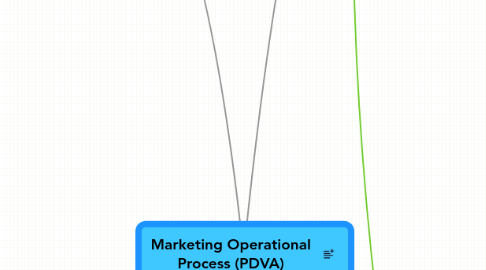
1. Implementation
2. Monitoring and control
2.1. Marketing information systems
2.1.1. Market research
2.1.2. Data analysis
2.1.3. Market intelligence
2.1.4. Reporting system
2.2. Marketing control systems
2.2.1. Areas of responsibility
2.2.1.1. Corporate marketing
2.2.1.1.1. Strategic control
2.2.1.2. Production marketing
2.2.1.3. Trade marketing
2.2.1.3.1. Annual plan control
2.2.1.3.2. Profitability and cash flow control
2.2.1.3.3. Efficiency control
2.2.2. Phases
2.2.2.1. Plan
2.2.2.1.1. Marketing CSF
2.2.2.1.2. KPI definition
2.2.2.2. Do
2.2.2.3. Verify
2.2.2.3.1. Evaluation frequency
2.2.2.3.2. Report format
2.2.2.4. Act
2.2.3. New marketing control systems
2.2.3.1. Trends
2.2.3.1.1. Value co-creation
2.2.3.1.2. Multichannel communication
2.2.3.1.3. Customer Experience Management
2.2.3.1.4. Brand management
2.2.3.1.5. CSF
2.2.3.2. Campaign-based
2.2.3.2.1. Web/mobile
2.2.3.2.2. Social networks
2.2.3.3. Customer-based
2.2.3.3.1. AAU
2.2.3.3.2. Brand equity
2.2.3.4. Customer lifetime value
3. Marketing plan
3.1. Marketing Mix
3.1.1. Product (offering)
3.1.1.1. Product
3.1.1.1.1. Concept
3.1.1.1.2. Levels
3.1.1.1.3. Hierarchy
3.1.1.1.4. Classification
3.1.1.1.5. Lifecycle
3.1.1.1.6. Brand
3.1.1.2. Service
3.1.1.2.1. Concept
3.1.1.2.2. Enlarged product
3.1.1.3. Information
3.1.1.3.1. Package
3.1.1.3.2. Label
3.1.1.4. Experience
3.1.1.4.1. Drivers
3.1.1.4.2. Evolution
3.1.1.4.3. Phases
3.1.2. Price
3.1.2.1. Drivers
3.1.2.1.1. Cost
3.1.2.1.2. Customer value (market value)
3.1.2.1.3. Competitors
3.1.2.1.4. Legal considerations
3.1.2.1.5. Lifecycle phase
3.1.2.1.6. Enlarged product (services)
3.1.2.1.7. Distribution channel
3.1.2.2. Policy (decisions)
3.1.2.2.1. Price positioning
3.1.2.2.2. Price variability
3.1.2.2.3. Price connection with product lifecycle
3.1.2.3. Phases
3.1.2.3.1. Objectives
3.1.2.3.2. Determine demand
3.1.2.3.3. Calculate costs
3.1.2.3.4. Analyze competitors
3.1.2.3.5. Select pricing method
3.1.2.3.6. Select final price
3.1.2.3.7. Price tactics
3.1.2.4. Real time
3.1.2.4.1. Dynamic pricing
3.1.2.4.2. Auctions
3.1.2.4.3. Negotiation
3.1.2.4.4. Reverse buying
3.1.2.4.5. Yield management
3.1.2.4.6. Group pricing
3.1.3. Place
3.1.3.1. Intermediaries (B2B)
3.1.3.1.1. Sales agent
3.1.3.1.2. Broker
3.1.3.1.3. Distributor
3.1.3.1.4. OEM/VAR
3.1.3.1.5. Service channels
3.1.3.2. Retailing (B2C)
3.1.3.2.1. Enlarged product
3.1.3.2.2. Decision process
3.1.3.3. Pull or Push decision
3.1.3.3.1. Service level
3.1.3.3.2. Objectives and constrains
3.1.3.3.3. Alternatives identification
3.1.3.3.4. Alternatives evaluation
3.1.3.3.5. Production schedulling
3.1.3.4. Distribution channel management
3.1.3.4.1. Selection & formation
3.1.3.4.2. Motivation
3.1.3.4.3. Communication
3.1.3.4.4. Evaluation
3.1.3.5. Evolution
3.1.3.5.1. Internet
3.1.3.5.2. Multichannel
3.1.3.5.3. Efficient consumer response
3.1.4. Promotion
3.1.4.1. Phases
3.1.4.1.1. Codify message
3.1.4.1.2. Decodify message
3.1.4.1.3. Response
3.1.4.1.4. Feedback
3.1.4.2. Classification
3.1.4.2.1. Internal communication
3.1.4.2.2. External communication
3.1.4.3. Process
3.1.4.3.1. Identify target audience
3.1.4.3.2. Determine communication objectives
3.1.4.3.3. Establish budget
3.1.4.3.4. Design the message
3.1.4.3.5. Communication mix
3.1.4.3.6. Process management
3.1.4.3.7. Result measurement
